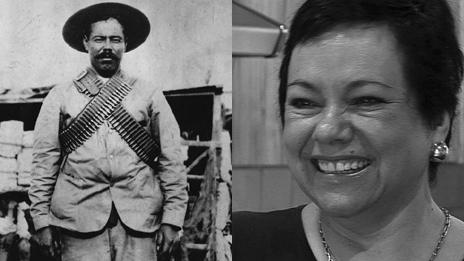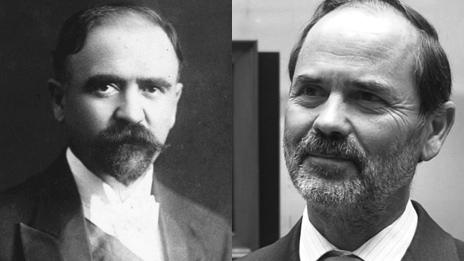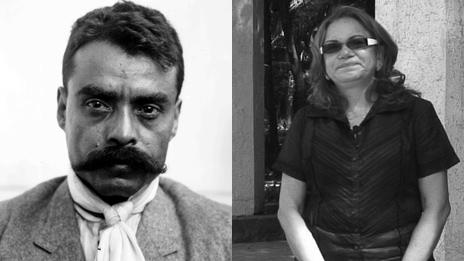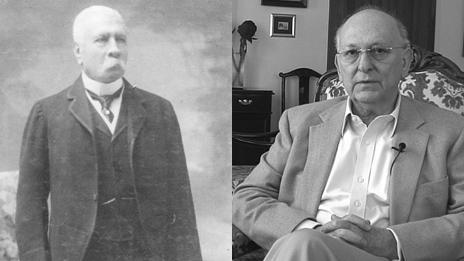Families recall key figures of Mexico's 1910 revoution
- Published
Mexico is marking the start of the revolution that convulsed and ultimately reshaped the country.
Amid the celebrations, the legacy of the revolt that began in 1910 and continued for the next 10 years is being scrutinised, discussed and re-evaluated.
Much of the focus is on the key figures of the time.
These include Francisco I Madero, who was the ideologue of the revolt; Francisco "Pancho" Villa and Emiliano Zapata - two of the revolution's most prominent leaders; and Porfirio Diaz, the Mexican president who was toppled by the revolt.
But for their descendants, history is intertwined with family memories.
Guadalupe Villa, Francisco "Pancho" Villa's granddaughter

Guadalupe Villa, a historian, says that all her life she has heard much about her grandfather's epic battles and travels across the country when he was leader of the northern front of the revolt.
But the glow of history does not blur her vision of him.
"He was a bandit, a womaniser and a fugitive and he wasn't that important in military terms," she says.
She says Villa remains a Mexican popular hero because "he was a man who emerged from the people, a peasant" and also, due to basic geography.
"Since he was based in a state (Chihuahua) that borders the US, then all the journalists, photographers and cameramen that came to cover the revolution talked to him, and he became a superstar known all over the world."
But the "superstar" - also lauded for resisting US intervention in Mexico - had a more personal side to him.
Ms Villa recalls the time when, during a brief retirement from political activity after 1920, Villa decided to live with his children, including her father Octavio, on a ranch.
"He wanted to have the family life that he never had," she says.
But the family bliss did not last long: fearing an uprising, Mexico's new government ordered his assassination in 1923.
Gustavo Madero, Francisco Madero's great-nephew

As a senator of the right-wing National Action Party (PAN), Gustavo Madero feels the political weight of carrying the surname of the revolution's main ideologue.
"For me it is a great responsibility to behave like a Madero, with decency, ethics, and courage, and fight for a better Mexico," he says.
His great-uncle was the author of the San Luis manifesto, which called for the start of a rebellion against then Mexican President Porfirio Diaz on 20 November 1910, and he became Mexico's president almost a year later, in 1911.
Madero began his involvement in the struggles against the injustices of the Porfiriato, as the Diaz years are known, after a life-changing trip to Europe.
But it was also, says Gustavo Madero, a struggle that took place within the walls of the family home.
"Most of his relatives were supporters of Porfirio Diaz."
Francisco I Madero, he says, was a homeopath, vegetarian, and even dabbled in "spiritualism" - activities frowned upon by his conservative and wealthy family.
One hundred years on, the "black sheep" of the Madero family is a national hero.
"Everyone venerates Francisco Madero," says Gustavo Madero. "They appreciate him as a good man who fought for Mexico's development."
Margarita Zapata, Emiliano Zapata's granddaughter

Emiliano Zapata, the peasant leader who initially led the southern front of the revolution and later fought some of his allies, continues to inspire political struggles in Mexico.
As recently as 1994, the launch of the indigenous Zapatista Liberation Army (EZLN), led by Subcomandante Marcos, drew its main historical inspiration from Zapata.
But granddaughter Margarita believes that the popular perception of him is wrong.
"Unfortunately, the image of Emiliano Zapata is just that of a man with a sombrero, a moustache and cananas (cartridge belts)," she says of her grandfather, who was played by Marlon Brando in a film based on his life in the 1950s.
A century after the revolution, the Zapata clan, she says, has grown and has internal rivalries like other families - but they all mourned the death of Ana Maria, Zapata's last surviving child, in February this year at the age of 95.
For Margarita, a political activist, the issues that brought about the revolution - like land reform, her grandfather's main cause - still have to be addressed, yet in a different way.
"I think we have to make another revolution - a cultural, educational revolution; a revolution for jobs, values and principles that we have lost as a society."
Luis Porfirio Diaz, Porfirio Diaz's great-grandson

Porfirio Diaz does not enjoy the same gleaming light of history as other figures of the revolution since he was, in fact, its main enemy.
He had governed almost continuously from 1876. But resistance to his authoritarian rule sparked the revolution, which saw him forced out of power in 1911 and into exile in France, where he died in 1915.
His great-grandson defends the legacy of the Porfiriato in terms of the economy, culture and politics.
"For me, he is a very important example of a man who made a significant contribution to building this country; a solid state with healthy institutions that contributed to give Mexico unprecedented progress, making the country a leader in Latin America," he explains.
And according to Mr Diaz, a leadership consultant, history has been unfair to the former president.
"After the revolution, there was a period in which his rule was denied or portrayed in a negative light."
He and the rest of the Diaz descendants have a very different opinion.
"For our family, his figure deserves respect and affection, because his love for Mexico was so big that led him to sacrifice his own participation in the history of Mexico when he decided to quit politics."
Interviews by Ignacio de los Reyes and Julian Miglierini, BBC News, Mexico City